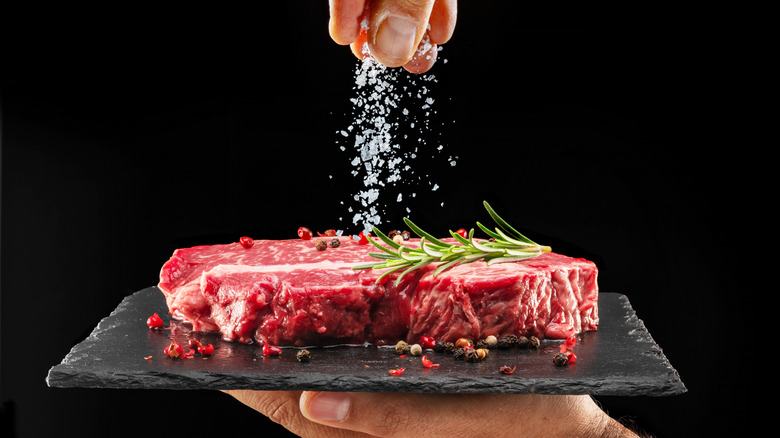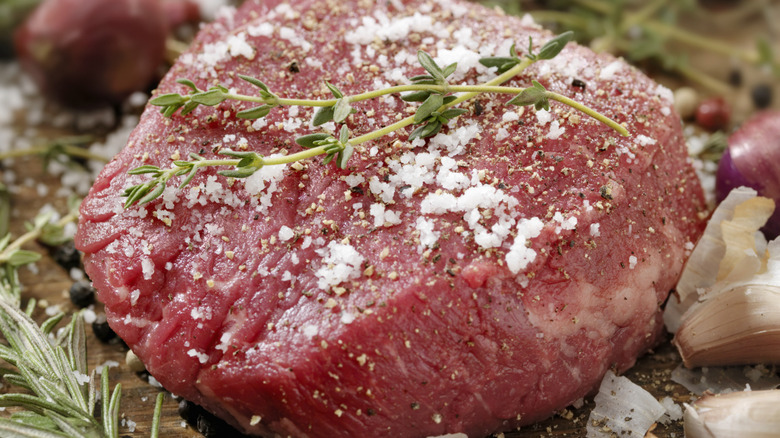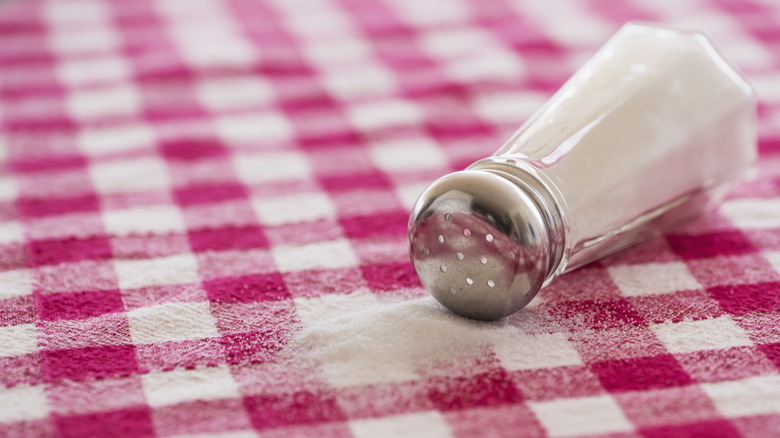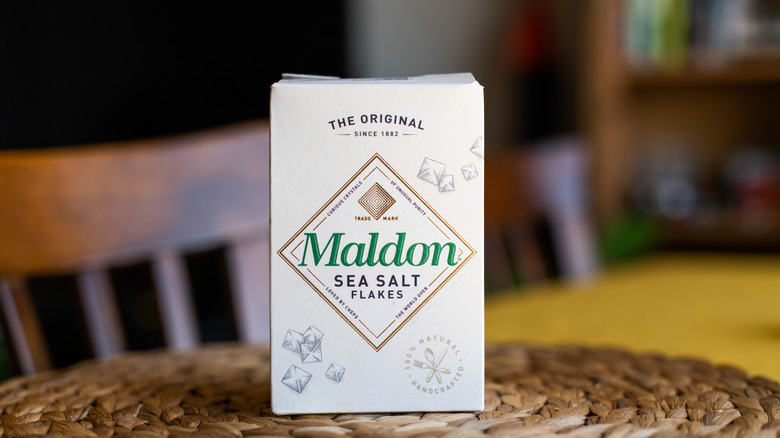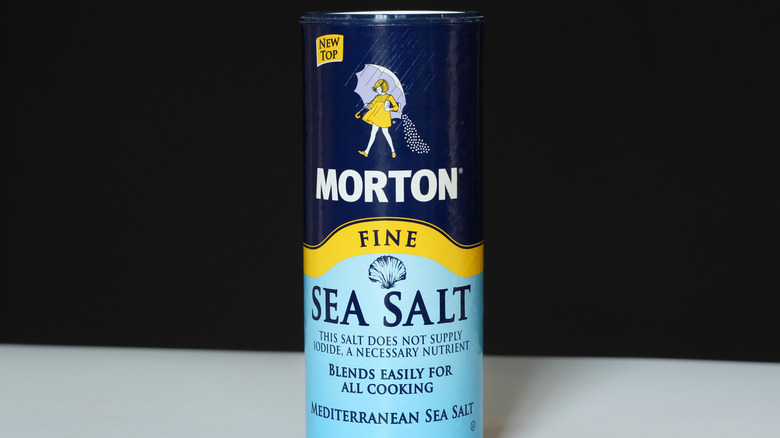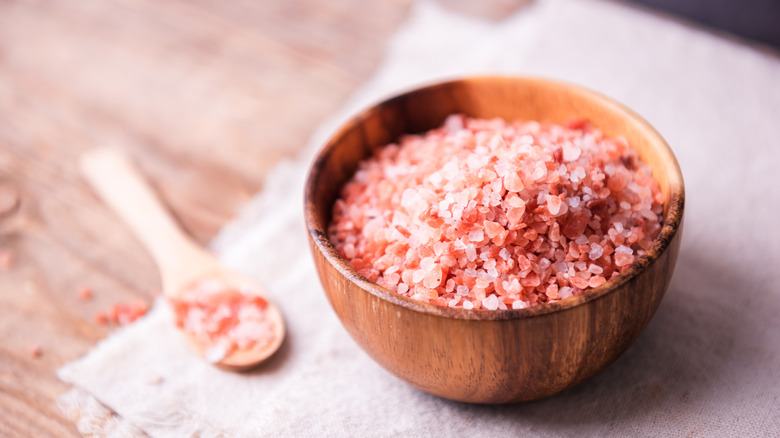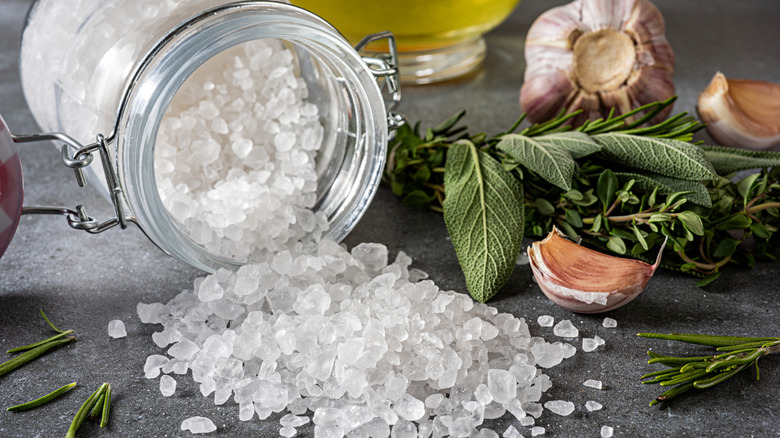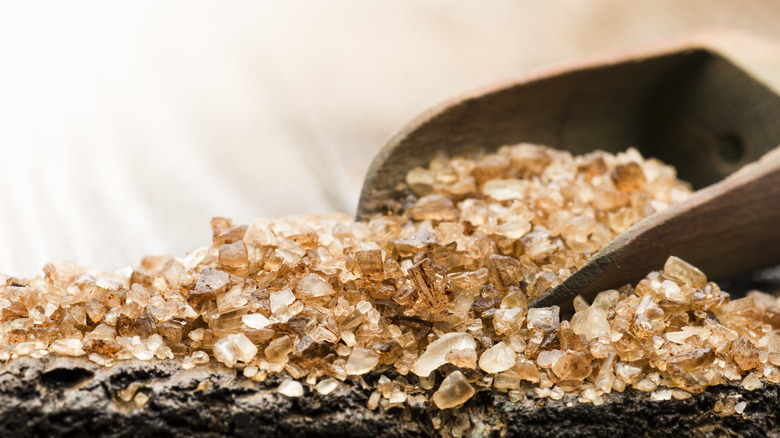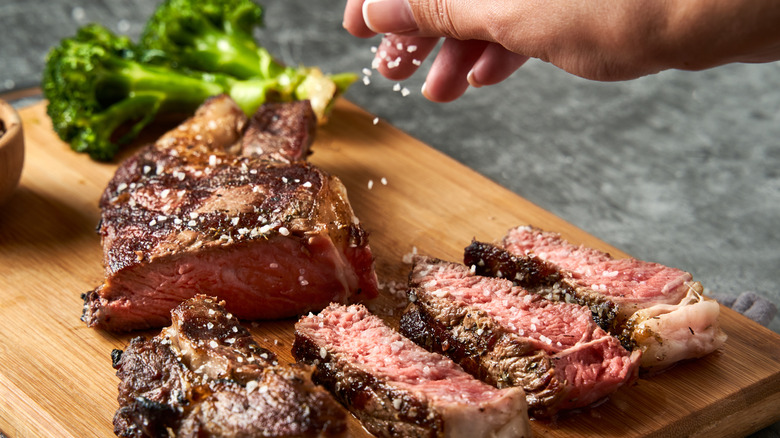4 Best Salts To Season Steak, And 4 You Should Avoid
Sometimes the best seasonings are the simplest, especially with a dish as classic as steak. Why make things complicated when all you really need is salt — that is, the right kind of salt. In an exclusive Food Republic interview, we spoke with Dennis Littley, chef and recipe expert at Ask Chef Dennis, for the nitty gritty on what salts to use with steak, which to avoid, and just how to use them.
Before diving into which salts to use during your grilling escapades, Littley helped remind chefs of the proper time to season your meat. According to Littley, "Ideally, steak should [either] be salted at least 40 minutes before cooking or right before it hits the pan or grill. Salting in advance gives the salt time to draw out moisture, dissolve, and then be reabsorbed, which helps season the steak more evenly and creates a better sear."
Salting in advance helps draw out the moisture and create a liquid brine that then redistributes into the steak. But, Littley adds that "salting 10-20 minutes ahead can pull moisture out without giving it enough time to reabsorb, which can lead to a drier surface." So it's either salt right before cooking, or with plenty of absorption time — but which salts should you use, or definitely not use, in the first place?
Good: Kosher salt
Chef Dennis Littley stated definitively, "The best salt for seasoning steak is kosher salt. Its large, flaky grains dissolve well into the meat, creating an even layer of seasoning that penetrates deeply." The large granules are better suited to salting steak because they dissolve more slowly, so they seep into the meat rather than creating an overly salty piece of meat. Yes, kosher salt is the end-all, be-all of perfect steaks.
Littley explained, "Kosher salt also makes it easy to control how much seasoning you're applying, ensuring the steak is well-seasoned without being overwhelming." So, while instinct may tell you that thicker salt would make your steak, well, saltier, it actually is what helps draw out the flavors without over-salting in the end.
Bad: Regular table salt
At the other end of the scale, the last thing you should be reaching for is your regular table salt. Dennis Littley informed us that "its small, uniform grains dissolve too quickly and can easily lead to over-salting." While it may seem like the easy way out, it's better to use it for seasoning in dishes with plenty of spices for added flavor instead of slapping it on your steak.
Another big reason for this, as Littley explained, is that table salt "contains iodine, which can sometimes create an off taste when used in large amounts." Iodine has a more metallic taste, which is not ideal for a juicy bite of steak –- so it's best to leave table salt for your veggies or eggs and let thicker salts do the real seasoning here.
Good: Coarse or flaky sea salt
According to Dennis Littley, "another great option is coarse or flaky sea salt, such as Maldon or fleur de sel." Flaky sea salt is a particularly crispy variety of salt that is known for its large crystals that have a unique flavor given these types, as the name implies, come from seawater. Sea salt is different from kosher salt in the sense that it contains small amounts of minerals, which contribute to that more complex taste — an aspect that makes sea salt better suited to last-minute salting as opposed to kosher.
Littley explained further that "these salts work especially well as a finishing touch, adding a crunch that enhances both texture and flavor." So, while you may be used to using sea salt for a contrasting crunch on fudge brownies, it's worth trying on top of your steak too. A bit of crunch from the crust and sea salt will go miles for delightful texture.
Bad: Fine sea salt
As you may have realized, the consistency of the salt you use for seasoning steak plays a big part in the flavor, hence why you should avoid finer textures. Dennis Littley said that "fine sea salt has a similar issue [to table salt]; because it's too fine, it doesn't provide the same texture or control as kosher salt, making it easier to overdo." After all, fine-grained salts are saltier than coarse varieties thanks to their weight-to-volume ratio.
So, while you may have sea salt in your pantry and think it's the right thing to use, be sure to read your label carefully to confirm it's appropriately coarse. In this case, it's better to use fine sea salt as a finishing salt to add some of its mineral taste to your dish without drying out your steak before it cooks.
Good: Himalayan pink salt
Perhaps the most aesthetically pleasing salt, Himalayan pink isn't just pretty, it's great for adding flare to your steak. According to Dennis Littley, Himalayan pink salt is a great choice because "it contains natural minerals that can add a subtle depth of flavor. While it doesn't dissolve as quickly as kosher salt, it works well when ground finely and used for seasoning before cooking."
It's worth noting that if you choose to keep Himalayan salt in its original coarse form, you may need to allow more time for it to absorb into your steak. However, the added flavor of the minerals may be worth the additional patience — just be careful not to use kosher and Himalayan salt interchangeably in other circumstances as their flavors are vastly different.
Bad: Rock salt
The exception to the rule, rock salt is one of the few larger forms of salt that isn't ideal for seasoning steak. Chef Dennis Littley explained that rock salt's "large crystals don't dissolve evenly, which can result in patches of under-seasoned and over-salted areas on the steak." Kosher and sea salt don't have this problem because they are made to be more uniform, both in thickness and shape, so they can evenly coat your steak.
Instead, you're better off using rock salt in specific cooking applications like as a base layer in the iconic oysters Rockefeller recipe. So while rock salt is a good coarse option in certain types of cooking and recipes, it's a reminder that looks can be deceiving.
Good: Smoked sea salt
While plain salt can be all you need to season your steak and draw out its signature flavors, sometimes we want a bit more kick. But never fear, Dennis Littley is here. Littley noted, "For those looking for a more intense, smoky flavor, smoked sea salt is a great option. It adds a subtle smokiness without overpowering the natural taste of the steak."
Made by smoking salt in an enclosed pan for several hours, smoked sea salts also come in a variety of flavors — meaning you can customize them to the overall feel of your meal without having to worry about the salt's texture. You can purchase smoked sea salts at most grocery or wholesale stores, or order them online to find a specific flavor profile. For example, hickory and cherrywood smoked salts complement steak well whereas something like an applewood is better for poultry.
Bad: Flavored or infused sea salts
Not to be confused with smoked sea salt, flavored or infused sea salts aren't as well suited for fully seasoning your steak. According to Dennis Littley, "flavored or infused salts, like truffle salt or herb-infused varieties, should be used sparingly. While they can add a unique twist, they often mask the natural flavors of the steak rather than enhancing them."
Think of it like drowning the steak instead of bathing it in flavor; the infused salts don't draw out the taste of the meat as much as other varieties, so they are better used as a finishing sprinkle — a light finishing sprinkle, that is. In the end, it may be worth going back to the basics like kosher salt for initial seasoning, then letting the flavored sea salts be the proverbial cherry on top.

